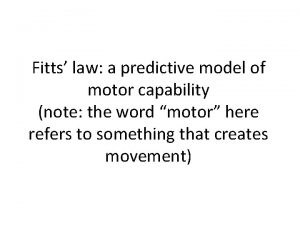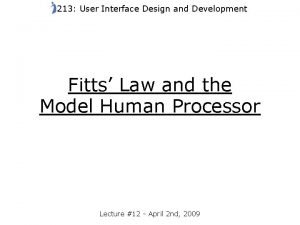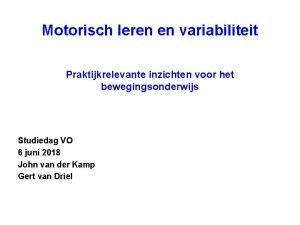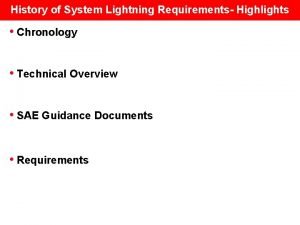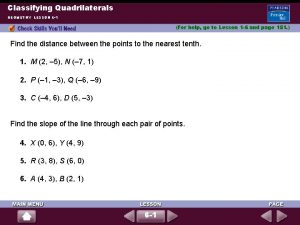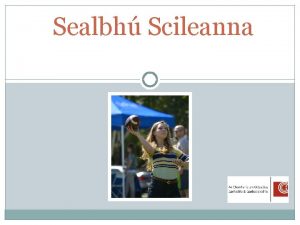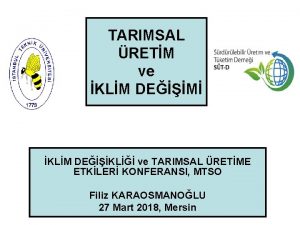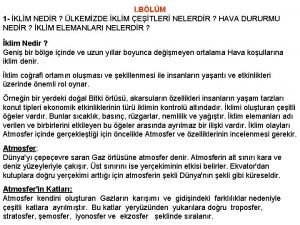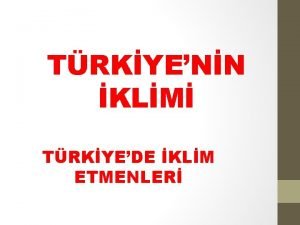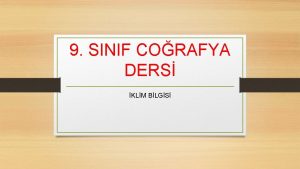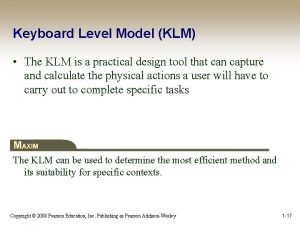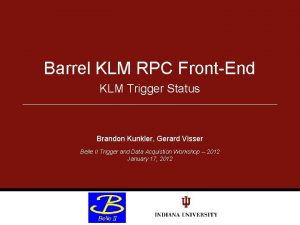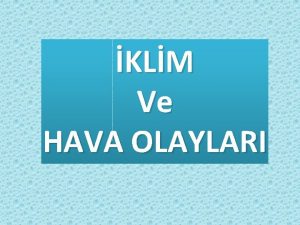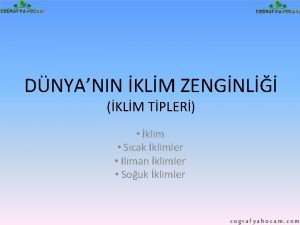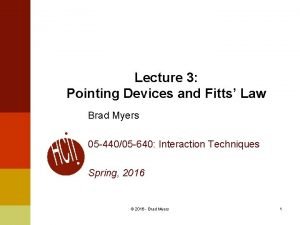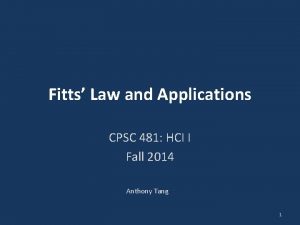CS 160 Discussion Section Fitts Law and KLM













- Slides: 13

CS 160 Discussion Section Fitts Law and KLM David Sun Sept 26 th 2007

Fitts Law (recap) • A model for computing the time it takes to move the hand/pointer to a target. • Formula: a + b log (D/S +1) – D: distance to the target – S: width of the target measured along the dimension of motion. – a, b: constants determined through regression.

Example:

More on Fitts Law • A number of formulations exist. We use the Shannon Formulation (by Mackenzie). – Slightly better fit to data – Keeps ID positive – Fits with underlying information theory • Index of difficulty (ID): log (D/S +1), measured in bits. • Index of performance (IP) : 1/b, measured in seconds/bit. • IP is independent of the particular target.

More on Fitts Law • Limitations: – One dimensional model of human movement – But often applied to two dimensional target acquisition tasks. D D start S S

More on Fitts Law • The amplitude of the move and the width of the terminating region are measure along the same axis. start D D D start D S start S

Examples: D S start S D D S start

Fixes • Smaller-of: smaller of the two dimensions (since small side is more indicative of the task complexity). Computes a upperbound. – Requires both dimensions and D – Simple but less accurate. • Calculate W’ through trig functions. – Requires everything Smaller-of needs + angle of motion.

Keystroke Level Model • Describe the task using the following Operators – K: pressing a key or a pressing (or releasing) of a button • T(K) = 0. 08~1. 2 seconds (~0. 2 avg) – P: pointing • T(P) = 1. 1 seconds (without button presses) – H: homing (switching device • T(H) = 0. 4 sec – D(n, L): drawing segmented lines • T(D) = 0. 9 n + 0. 16 L – M: mentally prepare • T(M) = 1. 35 s – R(t) : system repsonse time • T(R) = t

KLM Heuristic Rules (Raskin) 0: Insert M – in front of all K – in front of all P’s selecting a command (not in front of P’s ending a command) 1: Remove M between fully anticipated operators – MPK PK 2: if a string of MKs belong to a cognitive unit, delete all M’s except the first – 4564. 23: MKMKMKMK MKKKKKKK 3: if K is a redundant terminator, then delete M in front of it – [enter]: MKMK MKK 4 a: if K terminates a constant string (command name) delete the M in front of it – cd [enter]: MKKMK MKKK 4 b: if K terminates a variable string (parameter) keep the M in front of it – cd class [enter]: MKKKKMK MKKKKKMK

More on KLM • Basic underlying cognitive assumption: – Serial stage model of human information processing: one activity is done at a time until a task is complement. – No parallel activities, no interruptions and interleaving goals. • Others models: NGOMSL (overlapping human activities), CPM-GOMS (more rigor)

Example: K: pressing a key or pressing and releasing a button = 0. 2 s P: pointing = 1. 1 s (without button press) H: Homing (switching device) = 0. 4 s M: Mentally prepare = 1. 35 s

Example
 Fitts law formula
Fitts law formula Fitts law ux
Fitts law ux Fitts law user interface design
Fitts law user interface design Fitts en posner
Fitts en posner Frank fitts
Frank fitts Fitts list
Fitts list Newton's first law and second law and third law
Newton's first law and second law and third law Newton's first law of motion
Newton's first law of motion Simple distillation observations
Simple distillation observations Ac 20-136b
Ac 20-136b 6-1 classifying quadrilaterals
6-1 classifying quadrilaterals Angle klm and angle mln are a linear pair.
Angle klm and angle mln are a linear pair. Boyles law
Boyles law Boyle's law charles law avogadro's law
Boyle's law charles law avogadro's law
